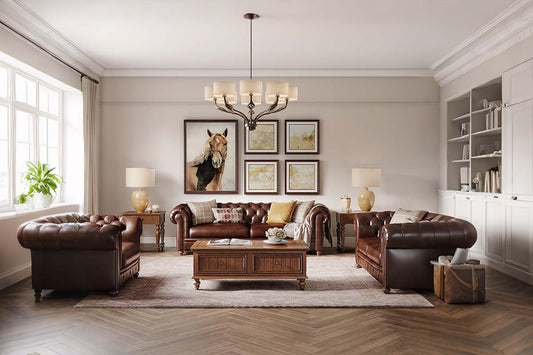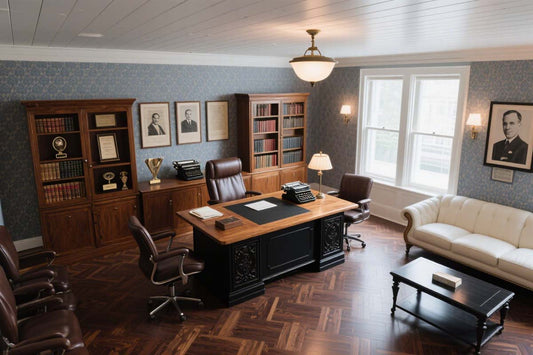
How Do Executive Leather Office Chairs Show Status in Meetings?
Share
In high-level meetings—whether in boardrooms or diplomatic forums—seating is never random. Every chair reflects power, protocol, and professionalism.
As a premium office chair retailer, we’ve spent years supplying executive seating to corporations and institutions. We’ve seen how the right chair not only offers comfort but also communicates status and respect.
At multinational corporations’ annual board meetings, the chairs at each end of the table often become an unspoken dividing line. At the head of the table sits a dark brown, high-back leather chair, with its solid armrests and refined stitching signaling authority. The other attendees, meanwhile, are placed in lower, simpler chairs. Before a single word is spoken, the hierarchy between leader and members has already been communicated through seating.
A chair has never been just a piece of furniture. In high-level meetings, it embodies status, respect, and authority. The choice of seat goes far beyond personal comfort—it is a silent language of power.

Why Does Seating Order Matter in High-Level Meetings?
When leaders gather—be they corporate CEOs, government officials, or international diplomats—the way they’re seated communicates status, authority, and strategic positioning. Seating protocols are not merely logistical details; they are essential instruments of diplomatic etiquette and corporate hierarchy.
Is There a Standard for Seat Positioning?
Yes, and it often follows these basic principles:
- The most important person sits at the head of the table, facing the entrance.
- The second-most important sits to the immediate right, then the third to the left, and so forth in an alternating pattern.
- In roundtable settings, which symbolize equality, the chair’s design, armrests, and back height may still indicate subtle distinctions.
These norms are practiced in boardroom configurations, government bilateral talks, and even G20 summits, albeit adapted to the cultural context.

Do Executive Leather Office Chairs Signal Power Differently Across Industries?
How Does the Type of Chair Reflect Rank and Function?
While many focus on position, the type of chair used in a meeting also speaks volumes. From leather executive office chairs to minimalistic side chairs, the material, design, and even the ergonomic features reveal subtle (or not-so-subtle) hierarchies.
What Is an Executive Chair vs. a Standard Chair?
An executive leather office chair—high-backed, cushioned, often with genuine leather—is usually reserved for top decision-makers. Its design offers not only physical comfort but symbolic stature. For example:
- High-back leather chairs with adjustable lumbar support signal authority and permanence.
- Mid-back swivel chairs are typically assigned to mid-level participants.
- Armless guest chairs or stackable conference chairs denote either support staff or visiting guests.
In formal settings, the luxury level of the chair must match the protocol rank. No detail is too small when representing authority and respect.
Who Knew Office Chair Etiquette Varied Across the Globe?
Seating customs vary slightly across cultures:
- In China, seats facing south are historically reserved for the host or most senior person.
- In Middle Eastern protocols, senior guests are seated to the right of the host.
- In Western boardrooms, the head of the table rule dominates, but chairs often serve as silent signifiers—with the CEO’s chair distinctively more luxurious.
Understanding these subtleties is crucial for multinational organizations and event planners.

Can the Wrong Chair Cause Offense?
Absolutely. Misplacing a dignitary in a less prestigious seat—or offering a lower-grade chair—can result in diplomatic friction. There are historic examples, such as the infamous “Sofagate” incident during a 2021 EU-Turkey meeting, where the absence of a proper chair caused embarrassment and political debate.
This is why major conference planners always conduct seating rehearsals and prepare chair hierarchies based on protocol charts.
How to Choose the Right Chair for Boardroom and Diplomatic Settings?
Selecting the right chair for high-stakes meetings requires a balance of:
- Design: Executive chairs should have a visual impact—clean lines, rich materials like genuine leather or Italian fabric.
- Functionality: Adjustable height, tilt tension, and lumbar support for long hours.
- Symbolism: The seat should reflect the stature of the occupant.
Professionals often turn to specialized suppliers of luxury office chairs for this purpose. For example, models like the Povimo Executive Leather Collection offer genuine leather craftsmanship, ergonomic features, and silent glide wheels—perfect for both boardroom and bilateral meeting rooms.
What’s the Role of Office Chairs in Boardroom Power Dynamics?
In the corporate world, furniture is branding. The executive office desk chair is no longer just about comfort—it’s about presence.
When selecting office chairs for boardroom use, consider:
-
Uniformity for staff, contrast for leaders
-
Matching chair styles with the tone of the meeting (e.g., high-back for strategic meetings, minimalistic for creative workshops)
-
Chairs that respect posture, especially for older or senior participants
Using the wrong chair in the wrong position can dilute a leader’s influence—even before a word is spoken.
Frequently Asked Questions (FAQ)
1. Why do participants of different ranks sit in different chairs during major meetings?
In formal meetings, the style, material, and comfort level of a chair represent the attendee’s status. High-ranking executives are typically seated in high-back genuine leather executive chairs, while standard chairs are assigned to middle management or support staff. This practice follows international protocol and conveys respect and order.
2. How should seating arrangements be planned based on attendee roles?
The general rule is “host first, then alternate sides in descending rank.” The host or top-ranking individual sits at the most visible and central seat—often facing the room entrance or main screen—with others arranged by rank on either side. In international meetings, cultural seating customs and interpreter placement must also be considered.
3. How can seating mistakes be avoided in diplomatic or multi-party conferences?
We strongly recommend preparing a detailed seating chart and a chair assignment checklist in advance, followed by a physical rehearsal. It’s also wise to communicate with each delegation to confirm preferences, sensitivities, or protocol requirements, minimizing risks of discomfort or diplomatic missteps.
4. What features should an executive conference chair include?
An ideal high-end conference chair should feature: genuine leather upholstery, a tall supportive backrest, an optional headrest, adjustable armrests, lumbar support, silent caster wheels, and multi-angle recline. These not only provide long-hour comfort but also project authority and stability.
5. Which office chair brands are suitable for high-level meetings?
Top choices in the market include Povimo, Herman Miller, Steelcase, Humanscale, and Povimo Executive Chair Collection, for instance, offers a range of luxury leather chairs designed with ergonomic precision and boardroom elegance—ideal for government agencies, international forums, and corporate leadership spaces.
Conclusion: Executive Leather Office Chairs Reflect Professional Authority
In major conferences and board-level meetings, a seat is never just a seat. From the placement of the chair to its material, color, and height, every detail speaks to the invisible protocols of status, etiquette, and influence.
Whether you're organizing a CEO summit, a government roundtable, or a shareholder meeting, remember: protocol is power, and chairs are its silent ambassadors.
And if you're preparing a high-level boardroom or formal diplomatic space, ensure you invest in seating that speaks your language—powerfully, respectfully, and unmistakably.
Explore curated collections like the Povimo Executive Chair Series, where design meets diplomacy.



